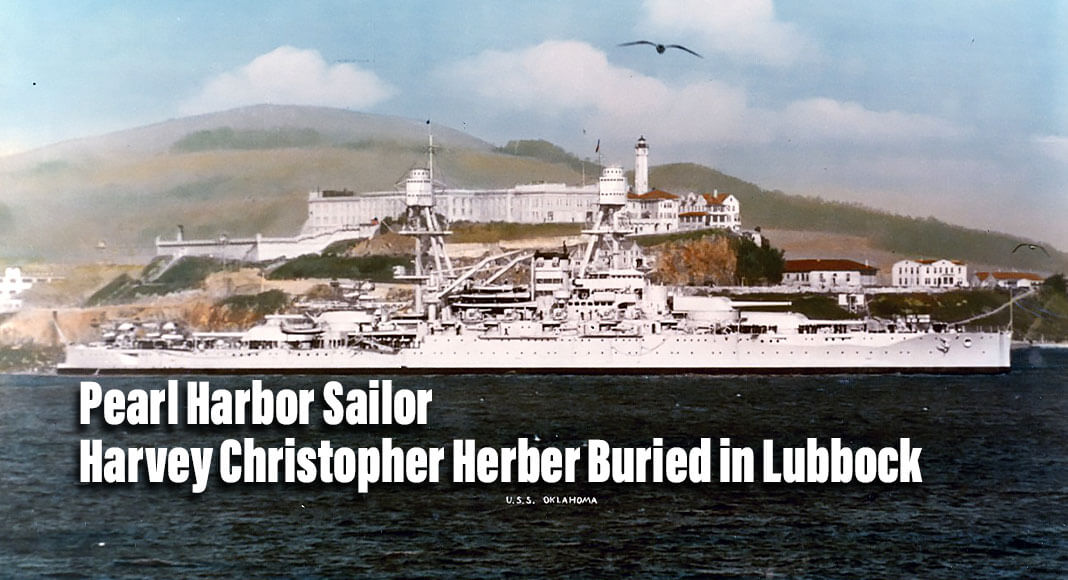
Texas Border Business
Electrician’s Mate 1st Class Harvey Herber, born in Tacoma, WA, who died during the Dec. 7 attack on Pearl Harbor, was buried at 2 p.m., Peaceful Gardens Cemetery, Lubbock, TX on March 24, 2023.
Harvey Christopher Herber
Birthplace: Tacoma, WA Date: Nov. 21, 1907 Hometown:Tacoma, WA
Rank/Rating: Electrician’s Mate 1st Class (EM1c)
Description: Members of the Artificer Branch, Electrician’s Mates used electrical tools, repaired electrical equipment and telephone circuits, charged storage batteries, stood watch on the ship’s main switchboard, main gyro compass, and in main control room. They maintained and repaired electrical circuits and electrical equipment. In January 1944 the Electrician’s Mate rating was moved to the Engine Room Force.
Loss Date: Dec. 7, 1941
Duty Station:
USS Oklahoma (BB 37)
Awards and Decorations*Purple Heart Medal Combat Action Ribbon Good Conduct Medal
American Defense Service Medal (with Fleet Clasp) Asiatic-Pacific Campaign Medal (with Bronze Star) American Campaign Medal
World War II Victory Medal
*This list reflects only those awards and citations present in the service member’s Official Military Personnel File and listed in the Navy Department Awards Web Service site and may not be complete.
Frequently Asked Questions:
**The following answers can be attributed to Capt. Robert McMahon, Director, Navy Casualty Office.
How many Sailors have been identified from the USS Oklahoma disinterment?
Prior to the 2015 disinterment, which marked the beginning of Project Oklahoma, 388 service members were unaccounted for. Since then, 355 have been individually identified.
Who makes identifications, and how?
Scientists at Defense POW/MIA Accounting Agency (DPAA) labs in Joint Base Pearl Harbor- Hickam, Hawaii, and Offutt Air Force Base, Omaha, Nebraska, identify past-conflict Sailors. Remains are identified using DNA reference samples from USS Oklahoma families; DoD now has more than 361 of required samples to support DNA analysis on Oklahomaremains as well as many medical and dental records from the Oklahoma service members.
What is the basic identification process?
The DNA profiling process begins with a sample of an individual’s DNA, typically called a
“reference sample.” During Project Oklahoma, The Navy reached out to families via letters and phone calls requesting their participation in the Family Reference Sample Program in efforts to possibly make a positive match, and identify their loved one lost on the USSOklahoma.
What is the Navy’s policy concerning family notification?
It is the policy of the Navy to notify the primary next of kin whenever there is a decision that impacts the remains of their family members.
What is the Navy’s notification process?
Once DPAA identifies a Sailor, the Navy Casualty Office makes the official notification to the Person Authorized to Direct Disposition (PADD). Following the notification a Navy Casualty case worker is assigned to the family to coordinate a formal briefing to discuss the identification, their wishes for disposition options. A Casualty Assistance Calls Officer (CACO) and Navy Casualty case worker conduct a Family visit/briefing with the family via various methods (Virtual,telephonically or in-person) and explain all entitlements, processes and assist with the finaldisposition of the remains.
How are CACOs assigned?
CACOs are assigned regionally, according to the location of the PADD.
How does the Navy support the fallen Sailors’ families?
Following the family visit/briefing, it is the CACO’s responsibility to assist the family with burial coordination.The family is given the choice to either have the Sailor re-interred at NMCP, or
choose an alternate location, such as a veterans’, private family site, or Arlington National Cemetery. Navy Mortuary, a branch within Navy Casualty, will coordinate the movement ofremains, which typically arrive a couple days prior to the burial.
What expenses does the Navy pay for?
The Navy pays for funeral expenses, family travel and lodging for up to three blood family members to the Service member. All funding/entitlements are handled and processed by the Navy Casualty office. Entitlements include casket, remains transportation, funeral home expenses and cemetery expenses. The Navy provides full Funeral honors (rifle salute, burial team and TAPS) details.
How can media get in touch with family members?
The Navy respects family wishes in regards to privacy. Each family contacted is asked to fill out a media release form, indicating whether or not media contact is desired. If a positiveresponse is given, the Navy Personnel Command Public Affairs Office will provide the requestingmedia
outlet’s information to the family member designated as the point of contact. Media will not be given family contact information.
Although it has been almost 80 years since the attack on Pearl Harbor, why do you believe it is important to identify the remains of these fallen heroes who lost their lives?
Briefing Families, I often hear, “we did not believe he was dead”, “probably he was not onboardthe ship”, “maybe one day he would walk through the door”. Being able to recover and identifythe remains of Sailors aid in closure for the Families and it is especially important to the Navy to Honor these Sailors who paid the ultimate sacrifice and gave their lives for our Country
What does it mean to the families to finally have this closure and bring their loved onehome?
Most often the notification and identification briefing is emotional, overwhelming and relieving allat the same time for the Families. Most Families cannot believe their loved ones were recoveredafter so many years, they prayed or hoped to have closure someday.
What can you tell me about the recent reinterment of Sailors in Hawaii?
Dec. 7, 2021: In a ceremony at the National Memorial Cemetery of the Pacific (NMCP), the 33 Sailors who could not be identified by DNA were laid to rest with full military honors.
In attendance were families of both unidentified and identified Sailors, as well as HawaiiGovernor Ige, USS Oklahoma survivor David Russell, and Navy and DPAA leadership.Presiding over the ceremony was the Honorable Carlos Del Toro, Secretary of the Navy.
U.S.S OKLAHOMA FACT SHEET
In 1911, Congress authorized the building of two battleships. These two battleships were the Nevada and the Oklahoma. They were to be a modern symbol of the power of the United States. The New York Shipbuilding Company of Camden, N.J., laid the keel for the U.S.S. Oklahoma in October 1912.
These two battleships would be the first to burn oil as fuel instead of coal.
The U.S.S. Oklahoma was commissioned at Philadelphia, Pennsylvania on May 2, 1916, with Capt. Roger Welles commanding. The commissioning statement of the Oklahoma stated “That it was hoped that the Oklahoma might never become a mere instrument ofdestruction nor of strife, but a minister of peace and a guardian of rights and interests ofmankind, protecting the weak against the strong.”
Attending the commissioning was the Assistant Secretary of the Navy, Franklin D. Roosevelt. As president, Roosevelt would declare war on Japan in 1941 after the attack at PearlHarbor.
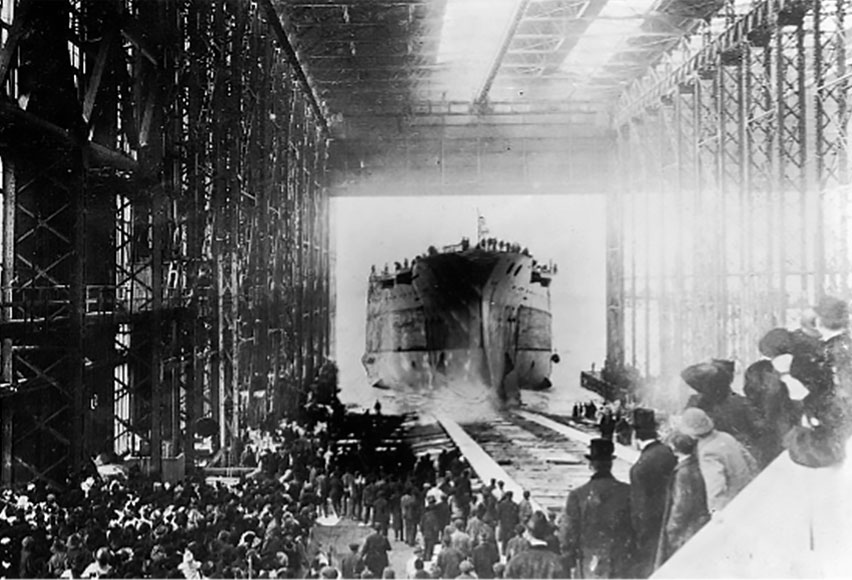
Milestones in the U.S.S. Oklahoma’s career:
August 13, 1918: Sailed with her sister ship, the USS Nevada, to protect and escort allied convoys in European waters in World War I until the war was over.
December 1918: Participated as an escort to President Woodrow Wilson traveling to France to negotiate the Versailles Treaty. In June 1919, returned to France to escort the presidenthome.
1919-1926: Part of the Atlantic Fleet for two years and then the Pacific Fleet for six years. Participated in the Peruvian Centennial and the unveiling of the San Martin Monument.
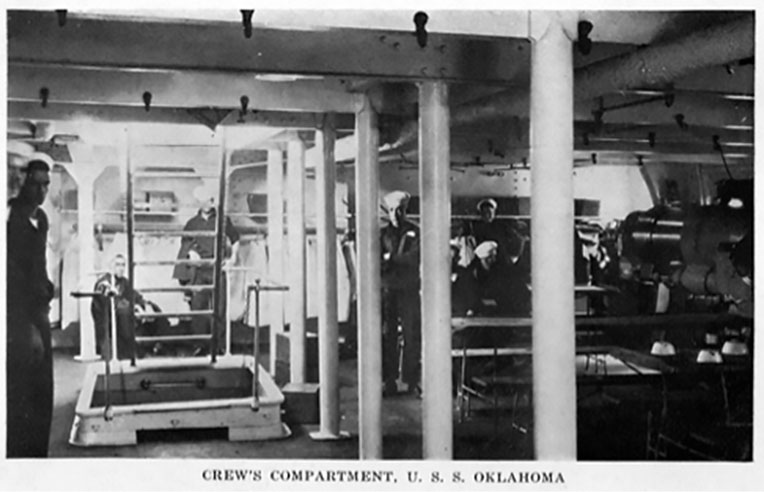
1927 – 1929: Modernized at Philadelphia, then rejoined the Scouting Fleet.
July 1929: Maneuvers were reduced during the Depression due to the lack of fuel oil.
1933: An earthquake hit Long Beach, California while the Oklahoma was docked there. Her crew deployed ashore to help maintain order.
1933: She participated in a civil defense drill in Tacoma, Washington, using the ship’s generators to provide all electrical power to the city for 24 hours.
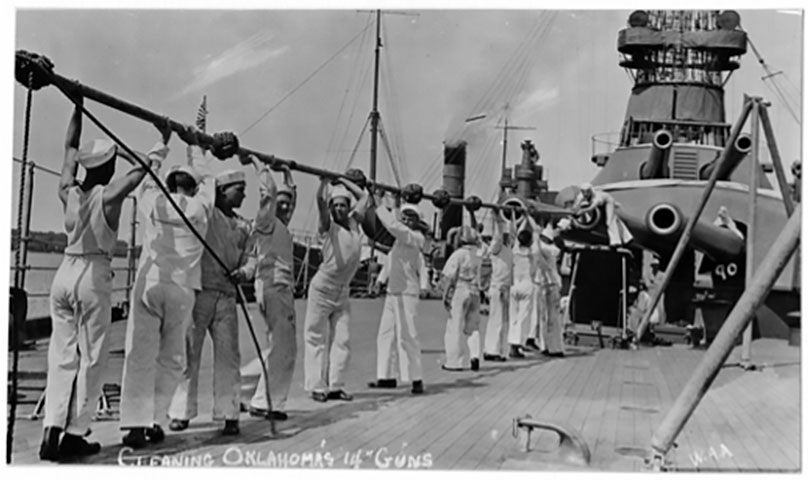
July 1936: Sailed to Spain to rescue American citizens and refugees of the Spanish Civil War. While enroute to France, a woman gave birth, the first time a baby was born aboard an Americanbattleship.
December 6, 1940: Based at Pearl Harbor for patrol and exercises. December 7, 1941: Pearl Harbor attacked by the Japanese.
December 7, 1941: Pearl Harbor attacked by the Japanese.
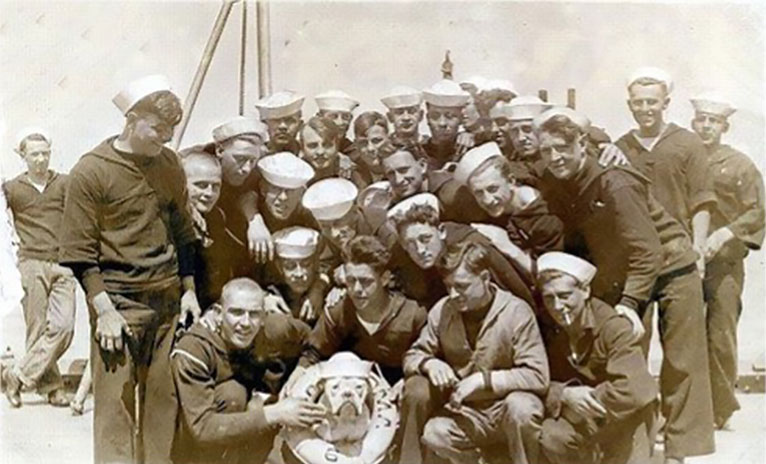
December 7, 1941
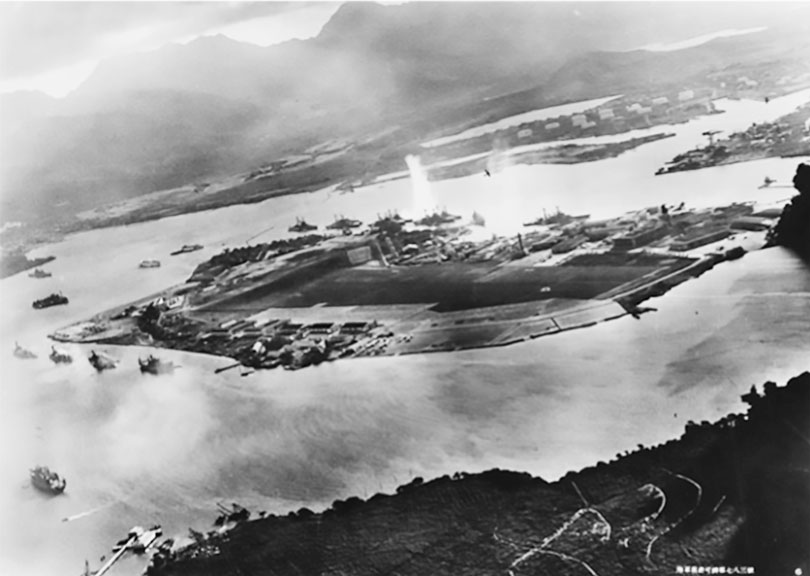
The USS Oklahoma was among almost half of the U.S. Pacific Fleet — consisting of 150vessels — lay at anchor at Naval Base Pearl Harbor Hawaii that Sunday morning when attacked byair forces of the Japanese Empire. Moored in Battleship Row beside the USS Maryland, the Oklahoma was among the first vessels hit.
The ship, under the command of Capt. Howard D. Bode, was actually supposed to be out to sea patrolling the Hawaiian Islands, but along with the other eight battleships at Pearl Harbor, the Oklahoma crew was advised there was to be an admiral’s inspection Monday.
When the attack began just before 8 a.m. Sunday morning, many of the crew were sleeping in their racks below decks and never made it up to the main deck.
At approximately 7:55 a.m. the first wave of Japanese aircraft struck the Oklahoma with three aerialtorpedoes.
The U.S.S. Oklahoma began capsizing as the Japanese planes strafed the deck with machinegun fire. After being struck by six more torpedoes, the Oklahoma’s port side was torn open and within 15 minutes of the fist torpedo strike, she had rolled completely over, trapping those crewmembers not fortunate enough to escape within her hull.

Amidst the chaos, several Sailors displayed their courage and comradeship, saving the lives of their shipmates at the cost of their own. For their efforts in saving their fellow Sailors, From left, Ensign Francis C. Flaherty and Seaman 1st Class James R. Ward would receive the Medal of Honor, the highest military award for valor. Chief Warrant Officer John A. Austin, who perishedsaving his shipmates’ lives, would be awarded the Navy Cross. Lieutenant Commander Hugh
Alexander, the ship’s dental officer, died helping Sailors to safety. Lieutenant Junior Grade (Chaplain) Aloysius Schmitt, far left, was conducting church call when battle stations sounded. His assigned position was below decks at a medical station where he could tend towounded sailors. He could have made it to safety, but he was assisting junior Sailors scrambling to safety when the ship capsized. Alexander and Schmitt would receive Navy and Marine Corps Medals, eventually upgraded to Silver Stars.
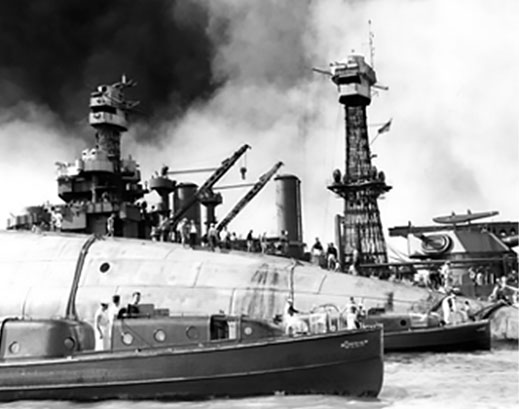
The U.S.S. Oklahoma would receive one battle star for her service in World War II.
The Lost 429
When the ship was righted in 1944, 429 Sailors’ remains would be recovered. Of these, only 35 were able to be identified. The remains of 388 unidentified Sailors and Marines were first
interred as “unknowns” in two cemeteries. All were disinterred in 1947, in an unsuccessfulattempt to identify more personnel.
In 1950, all unidentified remains from Oklahoma were buried in 61 caskets in 45 graves at the National Memorial Cemetery of the Pacific, also known as “Punchbowl.”
In April 2015, the Department of Defense, as part of a policy change that established threshold criteria for disinterment of unknowns, announced that the unidentified remains of the crewmembers of Oklahoma would be exhumed for DNA analysis, with the goal of returning identified remains to their families.
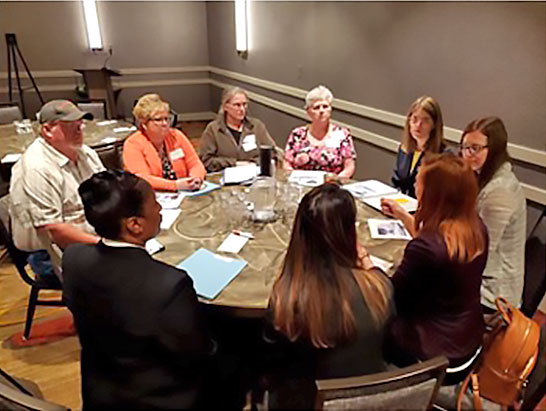
The process began in June 2015, when four graves (two individual andtwo group graves) were disinterred. Identifications have been made byscientists of the Defense POW/MIAAccounting Agency. Once identifications are made, the Navy Casualty Office, located at NavyPersonnel Command in Millington,
Tennessee takes control of the process, notifying and visiting with the families, coordinating thereturn of their loved ones and providing escorts and honors details for the reinternments.
December 2017: 100 Sailors had been identified.
February 26, 2019: The 200th Unknown Oklahoma Sailor was identified.
January 28, 2021: The 300th unknown (a member of the US Marine detachment) was identified.
December 7, 2021: On the 80th Anniversary of the attack on Pearl Harbor, the final 33 Sailors unidentified by DNA were reinterred at the National Memorial Cemetery of the Pacific.
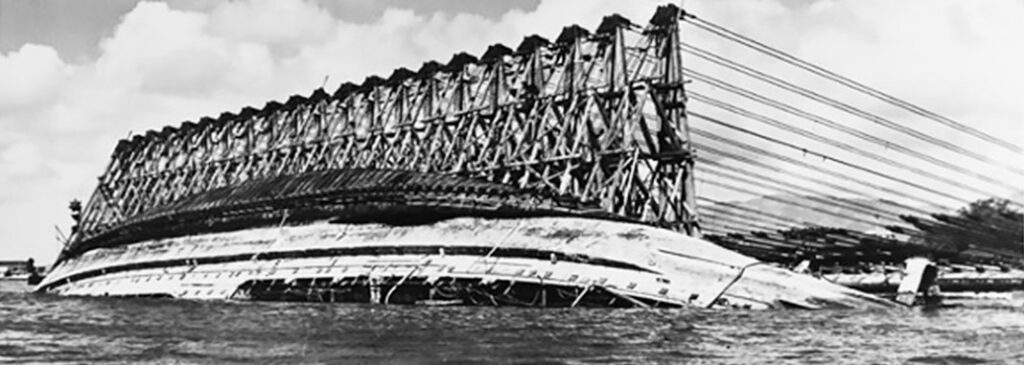
Salvage and Final Voyage of the USS Oklahoma
Salvage efforts at Pearl Harbor concentrated on the least damaged ships first, the Oklahoma and Utah were the last ships to receive serious attention.
Salvage of the U.S.S. Oklahoma began in March 1943. She was the most difficult and largest of the Pearl Harbor salvage jobs. Preparations for righting the hull took eight months tocomplete.
During the Oklahoma salvage, divers made 1,848 dives involving 10,279 man hours under pressure.
Air was pumped into interior chambers and improvised airlocks built into the ship, forcing 20,000tons of water out of the ship through the torpedo holes.
Four thousand, five hundred tons of soil were deposited in front of her bow to prevent sliding andtwo barges were posted on either end of the ship to control the ship’s rising.
Twenty-one derricks were attached to the upturned hull; each carried high-tensile steel cablesthat were connected to hydraulic winching machines ashore. The operation began on March 8, and was completed by June 16,1943.
Teams of naval specialists then entered the ship to remove any additional human remains.
Cofferdams were then placed around the hull to allow basic repairs so the ship could be refloated. The Oklahoma was eventually floated using 20 10,000 gallon-per-minute pumps during an 11-hour period on November 3, 1943.
December 28, 1943: Oklahoma towed into dry dock, repaired enough to make her watertight.
USS Oklahoma was decommissioned in September 1944 and sold to Moore Drydock Co. of Oakland, Ca., for $46,127. In May 1947, two tugs, Hercules and Monarch, began towing the Oklahoma to California.
May 17, 1944: The tugs entered a storm more than 500 miles from Hawaii. Hercules put her searchlight on the former battleship, revealing that she had begun listing heavily. After radioing PearlHarbor, both tugs were instructed to turn around and head back to port. Without warning, Hercules was pulled back past Monarch, which was being dragged backwards at 15 knots (17 mph). Oklahomahad begun to sink straight down, causing water to swamp the sterns of both tugs. To savethemselves, the crews released her and let her.
The Oklahoma’s plunge to the bottom of the Pacific was recorded at 1:40 a.m., but her exact location is unknown.
The ship’s wheel and a section of her deck are now on display at the Oklahoma Historical Society Museum. The anchor is located in downtown Oklahoma City, Oklahoma. Inscribed on its base: “Eternal Vigilance is the Price of Liberty.”
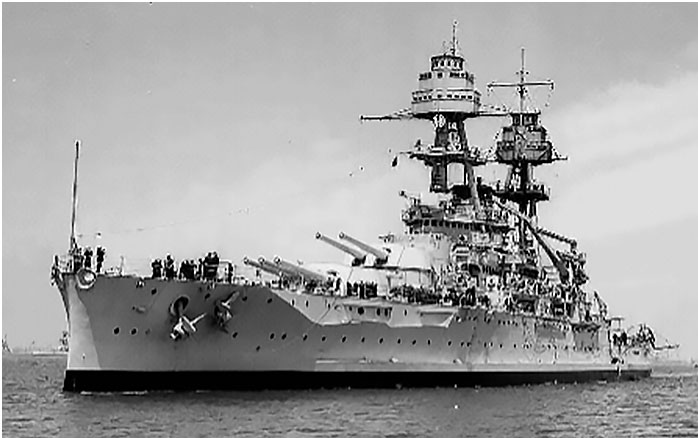
For more information:
US Navy POW/MIA:
https://www.mynavyhr.navy.mil/Support-Services/Casualty/POW-MIA-Branch/
Defense POW/MIA Accounting Agency and DNA Identification:
https://www.dpaa.mil/Resources/Fact-Sheets/Article-View/Article/569602/dpaa-laboratory/
















